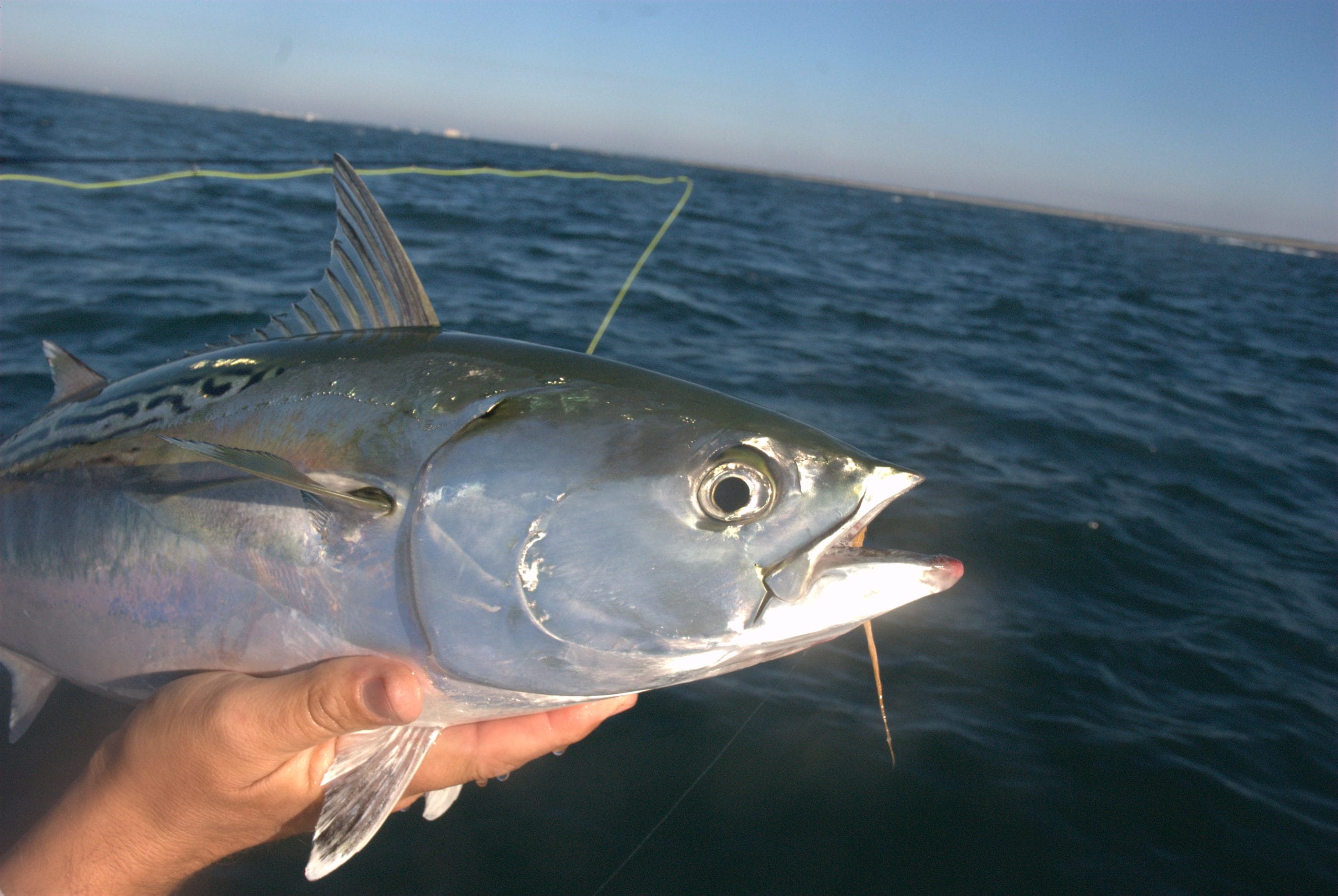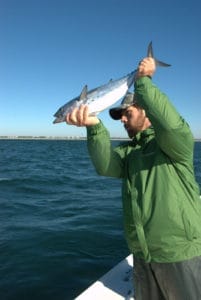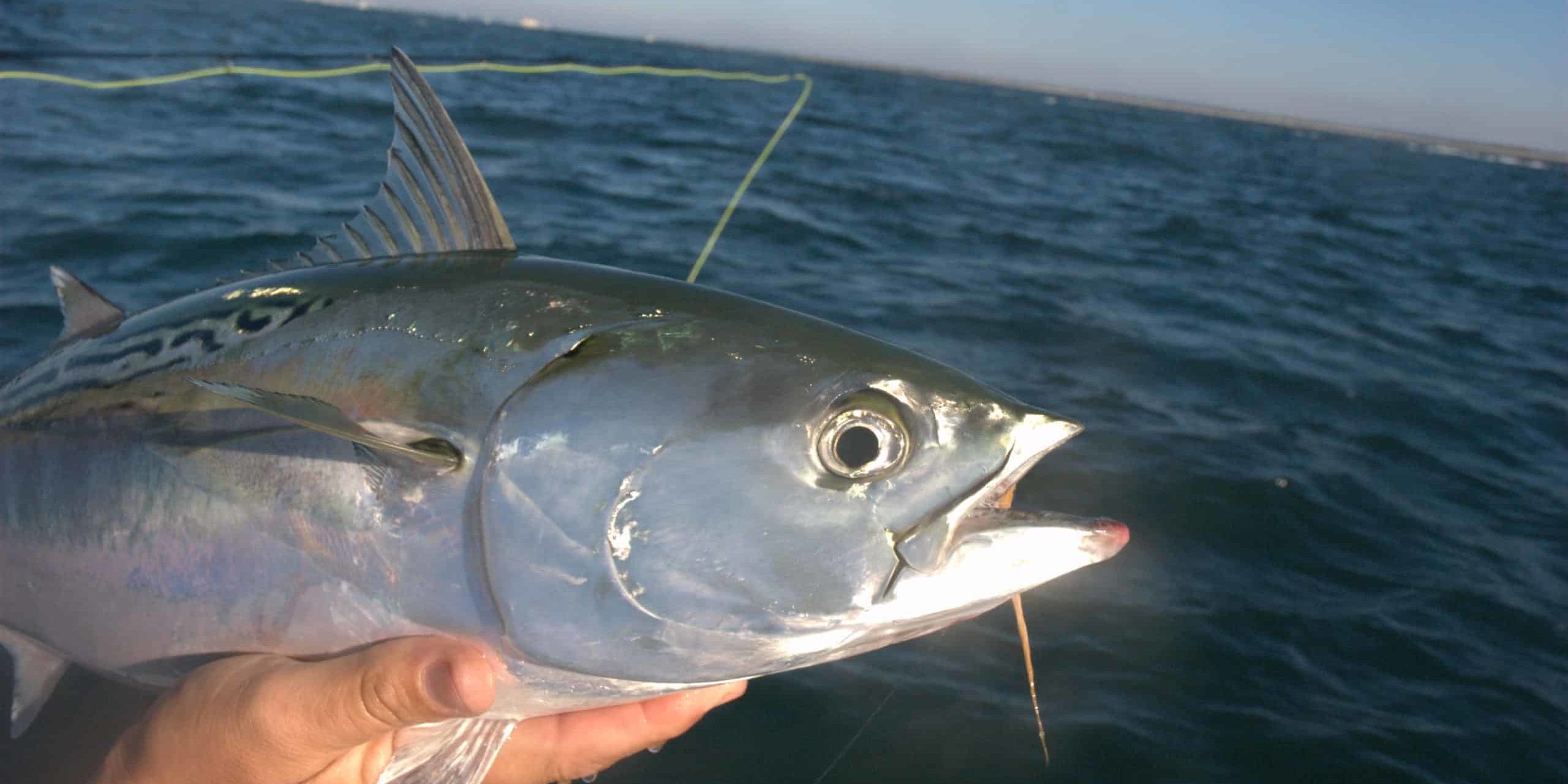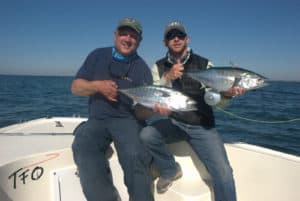by Beau Beasley
The harbor at Beaufort, North Carolina overlooked water as slick calm as a sheet of glass on the day I arrived to do some fishing with my father-in-law.

False albacore, also known as Little Tunny, may be the hardest fighting fish a fly angler will ever battle.
I hadn’t been fly fishing for false albacore fishing in more than a decade, but I well remembered how much fun it was the first time around. My beloved father-in-law John Johnson—JJ to those of us in the family—has long been my fishing buddy, and he and my mother-in-law Joan were in town visiting from the Pacific Northwest.
When we’re in JJ’s neck of the woods, we search for steelhead, so I was eager to introduce him to the sheer adrenaline rush of fishing for false albacore. I’d regaled him with stories of these hard fighters during our drive down from Virginia the day before.
“These fish are like nothing you’ve ever seen, John. Steelhead are tough, of course, but trust me when I tell you that this is the strongest fighting fish you’ll ever catch on a fly rod,” I said.
A mountain of a man, JJ is a retired forest ranger with 30 years of faithful service to his credit. Much of his service time was spent in places like Alaska, Montana, and Idaho. So having fought numerous wild land fires and seen more than his fair share of grizzly bears, JJ doesn’t impress easily. He seemed a bit skeptical and confidently replied, “You know, Beau, our steelhead are pretty hard to beat.”
I decided to let the false albacore do the talking for me.
Through the morning mist, Captain Gary Dubiel, of Spec Fever Guide Service, quietly motored up to the dock in his boat.
“Sorry you guys had to come all this way out to meet me,” he said, suppressing a smile.
“Yeah, it was rough,” I agreed.
“I don’t think I could have walked much further,” added JJ, turning to gaze at our hotel, the Inlet Inn, approximately 100 yards from the dock.
Situated in the historic district of Beaufort, the Inlet Inn is ideal for visiting tourists who want to walk around town, eat at the local seafood restaurants, and do a little shopping. The Inlet Inn overlooks the harbor, and its spacious rooms are often a jumping-off point for anglers looking for quick access to fishing haunts. In fact, the only way we could have gotten any closer to the water is if we’d slept on the beach. As we loaded our gear in the boat, I reflected that I’d rolled out of bed at 7 a.m., walked across the street for breakfast, and met my guide by a leisurely 7:45. Location is indeed everything.
False albacore—or “albies”—are more properly called Little Tunny. They can grow to 35 pounds, and make no mistake, they’ll tear your saltwater gear up if you’re not careful. How hard do these fish fight? Some marine biologists claim that albies can reach speeds of up to 40 miles an hour! They swim so quickly in part because they need saltwater to rush across their gills to breathe. Anglers who return false albacore to the sea usually thrust them back into the ocean like they’re throwing a spear.
Albies aren’t great eating fish—I don’t know anyone who eats them, in fact—but they sure can fight. Blistering runs of 100 yards in less than a minute are not uncommon. In fact, rookie anglers who wait for their first false albacore to slow down before trying get them under control have often seen their fly lines—and sometimes their rods—go overboard and never return. This much I can promise you: When you get into false albacore, you’d better be prepared to get up close and personal with your backing.

False albacore are fast swimmers that require movement of saltwater over their gills. Anglers release Little Tunny by “thrusting” them back into the water as if throwing a spear.
We motored out of the harbor and into an area just east of Beaufort and a few miles south of Cape Lookout National Seashore. In the distance I could make out a few wild ponies off of Shackleford Banks, an uninhabited island that used to be a major fishing village but now is home only to seagulls and wild horses. These horses are direct decedents of those brought over from Europe during the colonial period. Many of the ships sent over to colonize the New World sank not far from shore as a result of storms and hidden shoals. During low tide the horses often walk back and forth between the islands nibbling scrub grass.
“OK, boys, here they come. Stay focused and stay calm,” said Captain Dubiel, snapping me out of my reverie.
About 50 yards away I could see fish breaking the water and baitfish literally jumping for their lives. It actually looked like it was raining fish, except that the small baitfish were coming up from the ocean instead of down from the sky.
“Remember what I told you. I don’t give a hoot how far you can cast,” Captain Dubiel said. “Just be accurate, and when the fish hits your fly, don’t force him too much. Let him run for a while. Remember that these are very strong fish.”
The albies were barreling down on us; several broke the surface as they thrashed at the helpless baitfish. I looked over my shoulder to see Captain Dubiel placidly surveying the scene of ensuing pandemonium. This chaos was just another day at the office for him! My heart beat a little faster in anticipation.
The slashing fish churned the water before us into pearly white foam. Overhead the seagulls were screeching and diving to catch the hapless and stunned baitfish pushed to the surface by the marauding false albacore. The boat pitched in the wind and the deck moved beneath our feet—and all the while, JJ and I both cast as fast as we could. After making a few unsuccessful casts, I looked over my shoulder at JJ and saw that he was hooked up. His rod bent over and nearly touch the water, his reel screaming as the line played out. JJ’s mouth was closed, and I could tell that his teeth were clenched in his effort to keep his balance in the pitching seas and simultaneously keep pressure on his fish.
He looked up and gasped, “Wow, Beau, you weren’t kidding! These are super strong fish.”
That comment was all he could manage as he struggled to hold onto his rod. My reply was cut short by a solid jolt; my own line went tight. My reel spun, and the fight was on. In moments my rod was nearly bent to the water—and still JJ was doing all he could to land his own fish. Eventually, with the help of Captain Dubiel, JJ managed to land his first false albacore, and I put mine on the boat as well. We went on to battle more albies that day, but from the moment I saw his teeth clenched I knew, I wouldn’t be hearing anymore about JJ’s hard-fighting steelhead that day.
West Coast anglers tout their steelhead fishery and their big trout waters—both of which are fantastic, I admit—but for my money, nothing beats a school of hungry false albacore. If you’d like to try your hand at landing some of these street brawlers of the sea this fall, then make your plans now. And remember that albies are great sport on a fly rod—but visiting anglers to North Carolina can also prospect for red drum, flounder, stripers, and of course speckled trout. If you do manage to find a school of fast-moving albies, take my advice, humbly given: Clench teeth and hold on.
Fishing for false albacore can be a great deal of fun but requires some planning on your end to ensure a successful trip. Thrill-seeking fly anglers interested in pursuing albies, stripers, redfish, or speckled trout should contact Captain Gary Dubiel of Spec Fever Guide Service (www.specfever.com; (252) 249-1520). Visitors who plan to stay in Beaufort for any length of time should consider making The Inlet Inn their home base (www.inlet-inn.com; (800) 554-5466). The inn is located within easy walking distance of Beaufort’s historic district and many fine restaurants.
Beau Beasley (www.beaubeasley.com) is the author of Fly Fishing Virginia and Fly Fishing the Mid-Atlantic. He’s a retired Captain from Fairfax County Fire and Rescue and is a current member of Local 2068. Beau lives with his wife and children in Warrenton, Virginia.
The Union Sportsmen’s Alliance website is designed to provide valuable articles about hunting, fishing and conservation for members of AFL-CIO affiliated labor unions and all sportsmen and sportswomen who appreciate hunting and fishing and want to preserve our outdoor heritage for future generations. If you would like your own story and experience from the outdoors to be considered for our website, please email us at [email protected].





